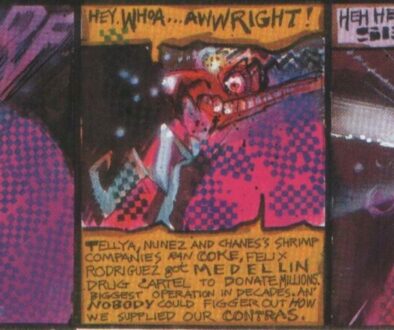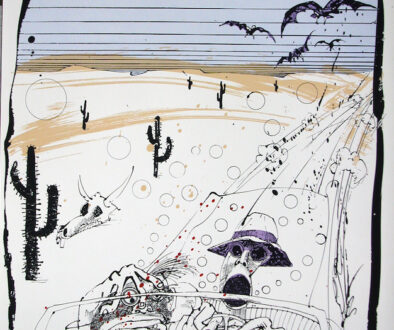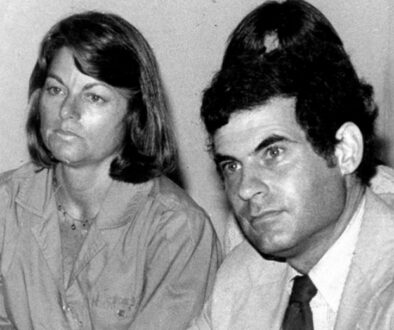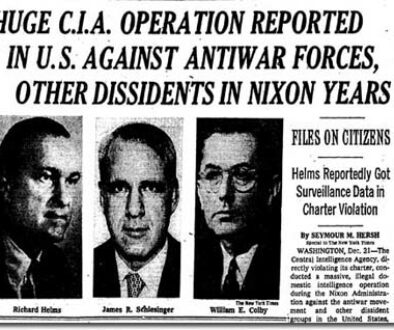 |
Figure 630: Peter Murphy in The Hunger. David J’s bass is visible on the
left. |
The result was a minor hit that stuck around in the independent charts for two years and, perhaps more significantly, marked the birth of goth music. Sticking with the period aesthetic from which they got their name and first single, Bauhaus quickly forged a distinctive visual style that drew from German Expressionism coupled with periodic trips to antique stores to, as J puts it, pick over “piles of moth-eaten Victorian velvet (in both the ladies and gentleman’s departments.”) This was coupled, in their live shows, by lighting design produced by Graham Bentley, who used stark industrial lighting and strobes to flood the stage with light, highlighting their monochromatic wardrobe. All of this served to highlight, in Moore’s words, “the rivetting stage presence of Peter Murphy as he writhes against his live backdrop of searing white light and contorted shadows” – a stage presence that would go on to become one of the defining images of goth culture when director Tony Scott used the song and Murphy’s performance for the opening credits of his classic 1983 vampire film The Hunger, with Murphy gyrating against and tearing at a wire mesh, a libidinous monster playing homage to the cinematic tradition Scott’s film succeeds.
 |
Figure 631: Moore’s text was eventually used as the cover
for Bauhaus’s live album This Is For When |
Moore, indeed, was one of the band’s early boosters, giving them one of their first pieces of national press in February of 1980 when he gave them a half-page writeup in Sounds, some eight months before their first full album, when they were still riding high on the back of two singles and a Peel session. Entitled “Phantoms of the Teenage Opera,” the piece concludes by proclaiming the band to have “a sound as clean as a razor, and a vision that doesn’t need dressing up in angry rhetoric or android accessories to make a point. Their music may have the shadow of the tall steel over it, but that’s a heartbeat you hear throbbing in the background, not a ring modulator. On yer bikes, the rest of you. Here comes the night shift.” Moore would also write the liner notes for the band’s second album, Mask under the pseudonym Brilburn Logue: “This is for when the slats of the night slam shut on you, for when the radio is broken and crackles like uranium orchids, for when the Föhn-wind rattles the telegraph wires like a handful of bones, and this is for when dream ambulances skitter through the streets at midnight. In the amusement arcade a sailor whose muscles writhe with pornography, doubled up, his vomiting emeralds. Elsewhere a black man with brass teeth and a swallow skin tie is laughing and laughing and offering poisoned candy floss to the children. This is for when your cuff gets caught in the cogs of an urban evening, for when your vision is frayed and you don’t have any more lust. This is for the wasp-woman. This is for the torturers’ wives with their thumbs blue as billiard chalk. This is for all the mathematicians who got mixed up in the dream gang. This is for when you get caught in a sleep riot, this is for when your jism turns to platinum, for when the television is full of murder, for when the sky is out of order, for when your room is crawling with cheap poetry. This is for when your veins are singing with indigo, for when the radiator is full of fever, for when your sex is full of voodoo, for when your clothes are imaginary, for when your kitchen is dead. This is for when your flesh creeps and never comes back.”
 |
| Figure 632: Bauhaus’s In The Flat Field |
Moore’s support for the band is hardly surprising – they were, after all, Northampton locals – indeed, one can read Moore’s liner notes for Mask as a sort of primitive ancestor of his Nighthampton dreamscape from The Show, and the strange and dreadful nature of the place was one of the first things Bauhaus tried to capture in their music. The title track of their first studio album, “In the Flat Field,” with its howled chorus of “I get bored, I do get bored in the flat field” is about, as J puts it, “the quotidian mundaneness of life in Northampton, and the desire to escape that flat existence.” And yet for all of this, Murphy’s lyric gives a sense of strange wonder to the place: “A gut pull drag on me / Into the chasm gaping we / Mirrors multi-reflecting this / Between spunk-stained sheet / And odorous whim / Camera eye-flick shudder within/ Assist me to walk away in sin / Where is the string that Theseus laid / Find me out of this labyrinth place.”
But the mutual connection to Northampton had a practical effect too, which is that Moore knew the band personally. David J had frequented an occasional event that Moore helped run along with a guy who alternately went by the name of Pickle and Mr. Liquorice, called the Deadly Fun Hippodrome that J described as “a mad anarchic surrealist cabaret,” and indeed played with Moore in an ad hoc band called the Sinister Ducks one afternoon when the scheduled entertainment failed to materialize. J had been slightly too young for the Arts Lab proper, but stuck around in the avant-garde scene of Northampton that Moore emerged out of, producing, for instance, a fanzine called TV Murders with Mr. Liquorice and Alan Moore. (Liquorice describes it as “kind of an anti-fanzine in that it featured no reviews or gig listings of any kind. Only surrealistic cut-ups and montages.”)
That a man who proposed naming his band after a German art school would have an investment in the avant-garde is perhaps unsurprising. And this is further reflected in the band’s music, which always balanced its self-consciously punk rawness with an art school level of self-awareness. Both Mask and their third album The Sky’s Gone Out contain songs assembled in an “exquisite corpse” style (Indeed, the latter song is actually called “Exquisite Corpse”). For the first one of these, simply called “1. Jay 2. Murphy 3. Haskins 4. Ash,” each member of the band contributed a short track composed to an agreed-upon drumbeat, with the resulting song stitching them together. “Exquisite Corpse” went with an even less restricted approach, dropping the drum track and letting the members run wild. They also produced an experimental film called Consequences with the same approach, and although J describes this as “extremely self-indulgent and overlong,” the fact that it exists reveals the commitment to this sort of self-consciously avant-garde style.
 |
| Figure 633: French playwright Antonin Artaud. |
This inspiration comes to a creative head in the second track of the band’s final album of the 1980s, Burning From the Inside, an homage to the French playwright Antonin Artaud, whose post-surrealist manifesto of the Theater of Cruelty remains one of the most radical visions of that medium ever espoused. In December of 1982, the band engaged in an “attempt to raise his spirit through a ritualistic performance” in Chicago, which consisted of the band stripping to the waist, covering themselves with UV-sensitive paint, and performed a concert consisting only of the song “Antonin Artaud,” deliberately stalling on the repetition of the line “red fix” for more than twenty minutes in an attempt “to induce a trance-like state in the audience and ourselves,” the audience having been instructed to bring some sort of percussion instrument to participate in the performance themselves. The goal, as J explains it, was “to break through the usual restrictions of a rock gig, where the audience is distinctly separate from the band,” so as “to attain a state of shared transcendence” and “shatter conventional perception through a violent, jarring, primitive rite, one that would go beyond ‘performance’ and become something shamanic, disturbing, and ultimately liberating. (We were, it has to be said, four very intense young men.)”
It will not escape attention that this description is self-evidently an act of magic and an aesthetic predecessor to J’s later magical workings with the Moon and Serpent Grand Egyptian Theatre of Marvels. This was not a coincidence. One of the singles off of The Sky’s Gone Out, “Spirit,” was, in J’s explanation, about a quasi-supernatural entity that attended the band, which he describes as “a kind of supportive daemon that could only be evoked if we were all in tune with each other.” The lyrics of the song make it clear that this is conceived of literally, giving the spirit voice as it explains that “Tonight I could be with you / Or waiting in the wings / Lift your heart with soaring song / Cut down the puppet strings,” while also threatening that “the stage becomes a ship in flames / I tie you to the mast / Throw your body overboard / The spotlight doesn’t last.” The song ends with Murphy repeatedly intoning “Call the curtain / Raise the roof / Spirit’s on tonight” before turning into a repeated chant that “we love our audience,” in what is difficult to take as anything other than a straightforward act of summoning.
A similar sort of spiritual invocation eventually emerged out of the song “Who Killed Mister Moonlight,” a “surrealistic ballad on Burning From the Inside inspired in part by the murder of John Lennon” whose title character was eventually taken by the band “as being representative of the dreamy, poetic aspect of Bauhaus.” J would end up taking the lead vocal on the song, and would go on to use its title for his memoir. This was, in practice, because Peter Murphy was ill during most of the production of Burning From the Inside, leading the album to mainly be assembled by his bandmates, with him providing lead vocals later. This deepened the sense of division between Murphy and the rest of the band that had been growing for some time, and hastened the band’s dissolution during the tour following the album. The other three eventually reunited as Love and Rockets, but not before J recorded and released the V for Vendetta EP in 1984.
 |
| Figure 634: Enid Blyton’s The Magic Faraway Tree |
But not all of the influences on V for Vendetta were so radically countercultural. Indeed, one of the biggest, from which the series would eventually draw the title of its third part, was almost ostentatiously mainstream: the work of Enid Blyton. Blyton was an exceedingly prolific British children’s writer in the early 20th century best known for her Famous Five and Secret Seven series, but for the purposes of V for Vendetta it is one of her lesser series, the Magic Faraway Tree series, that is most relevant. That series debuted in 1939 with The Enchanted Wood, which told the story of Jo, Bessie, and Fanny, who live near a large forest, which turns out to be the eponymous Enchanted Wood. (H.P. Lovecraft, describing the Enchanted Wood in The Dream Quest of Unknown Kadath, says: “In the tunnels of that twisted wood, whose low prodigious oaks twine groping boughs and shine dim with the phosphorescence of strange fungi, dwell the furtive and secretive Zoogs; who know many obscure secrets of the dream world and a few of the waking world, since the wood at two places touches the lands of men, though it would be disastrous to say where. Certain unexplained rumours, events, and vanishments occur among men where the Zoogs have access, and it is well that they cannot travel far outside the world of dreams. But over the nearer parts of the dream world they pass freely, flitting small and brown and unseen and bearing back piquant tales to beguile the hours around their hearths in the forest they love. Most of them live in burrows, but some inhabit the trunks of the great trees; and although they live mostly on fungi it is muttered that they have also a slight taste for meat, either physical or spiritual, for certainly many dreamers have entered that wood who have not come out.”) Within it, they find the Faraway Tree, whose “top reaches the far-away places… sometimes its top branches may be in Witchland, sometimes in lovely countries, sometimes in peculiar places that no one has ever heard of.” From this point the series becomes about the various adventures they have climbing the tree and going to the various lands along with their magical friends Moon-Face and Silky.
These adventures are described in Blyton’s characteristically straightforward prose style, which Colin Welch famously described as that of “the first successful writer of children’s books to actually write below her audience,” and which led to the BBC banning programs from inviting Blyton on the grounds that she was a “tenacious second-rater” who produced “mediocre material,” declaring that her voluminous output is the work of genius because “anyone else would have died of boredom long ago.” This is certainly a harsh assessment, but it is in truth difficult to argue. Consider, for instance, her account of the group’s adventures in the Land of Take-What-You-Want, in which “if you want anything, you can usually get it there for nothing.” At one point, the adventure goes as follows: “‘Do you want a nice fat lion, Jo?’ asked Silky, as a large lion wandered by and licked Silky’s hand. [continued]










February 5, 2015 @ 3:21 am
Not even Morgoth?
February 5, 2015 @ 4:25 am
[Grin]
February 5, 2015 @ 8:48 am
This comment has been removed by the author.
February 5, 2015 @ 8:50 am
An interesting insight into Blyton comes from an interview which I assume was on the BBC before they had this policy, and which I heard on the archive section of the Radio 4 panel game The Write Stuff. The Joyce Grenfell monologue "Writer of Children's Books" ("I never rewrite, and I never read what I've written") is just barely an exaggeration of it.
February 5, 2015 @ 9:32 am
I assume this is Aslan's origin story.
February 5, 2015 @ 9:37 am
Read back the quote about the fat lion but imagine Jon Pertwee as the Third Doctor saying it.
February 5, 2015 @ 9:47 am
To be fair to Blyton, the Faraway Tree stories are for younger readers than say the Secret Seven or Famous Five stories. And why do we praise Terrance Dicks for writing ruthlessly efficient prose and making a vital contribution to child children's literacy when Blyton has surely a stronger claim?
February 5, 2015 @ 9:54 am
Because we read Target novelisations as children so we wouldn't have to read the Famous Five? 🙂
February 5, 2015 @ 1:49 pm
Wasn't "None more goth" what the Scarlet Witch said when she inaugurated the House of G?
February 11, 2015 @ 5:14 am
Great stuff Phil. I haven't been able to catch up with reading on the Last War, but now that the Eruditiorum is done I will certainly be going back and catching up with posts (I have ordered Book 1 via Kickstarter anyway) and look forwards to reading more here.
February 13, 2015 @ 6:06 am
Love the textual link made between Enid Blyton and HP Lovecraft – brilliant!
February 14, 2015 @ 8:26 am
Oh, sure I used to like the Seven and Five, but as far as her work for younger readers goes, well, I'm not sure I was ever young enough for them. And I was still watching Sesame Street in my teens.
But even the books I liked came across as, well, very formulaic, and I wasn't at all surprised to learn she had a mildly cynical attitude to them. And she would never have come up with the opening sentence "Through the ruin of a city stalked a ruin of a man".
February 17, 2015 @ 3:23 am
That's what I love this blog for – where else could you find intersections between The Hunger, Enid Blyton, HP Lovecraft, Bauhaus and their song Bela Lugosi's Dead? Wow.
As I said previously, Bela Lugosi's Dead and Bauhaus were a major soundtrack of my college years and after. Reminds me of wonderful days in Edinburgh's underground blagging my way with friends fro free into music gigs posing as music journalists. Heady days!
March 2, 2015 @ 9:19 pm
Re: the title quote: This is happening later this month at ECCC:
None More Goth: Kate Leth vs. Kieron Gillen
Room: Hall D (TCC 302)
Time: 2:30PM – 4:20PM
Moderator: JD Boucher
Guest(s):
Kate Leth, Ray Fawkes, Kieron Gillen
The time has come to settle it once and for all. With the best panel of impartial Goth judges that can be gathered (Drew Rausch, Ray Fawkes, Robert Tritthardt, and Jillian Venters) Kieron and Kate's claim to the title will be put to the test with contests in Gothic knowledge, fashion, and more. Only one can be Most Goth.
I felt it needed to be mentioned here.